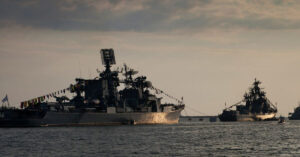
Capsized Barge Linked To Tobago Oil Spill Possibly Obtained Fuel From Venezuela
May 8, 2024
Yemen’s Political Disputes Delay Full Repairs Of 3 Submarine Internet Cables In The Red Sea
May 8, 2024

Germany sent two warships to the Indo-Pacific area to bolster its military presence amid increasing tensions between Taiwan and China and over the highly disputed South China Sea.
The country’s Defence Minister, Boris Pistorius, said that these tensions have been straining freedom of navigation and free passage on trade routes.
About 40% of Europe’s foreign trade flows via the South China Sea.
He informed the reporters before the vessels set sail that exhibiting no presence in the Indo-Pacific in support of the international rules-based order is not even an option for Germany. He further said that presence matters.
Beijing claims nearly the whole South China Sea as its own, despite a global tribunal ruling that it has zero legal basis for such claims.
Despite the latter’s intense objections, China claims democratically governed Taiwan to be part of its territory.
The supply vessel Frankfurt am Main started sailing from Wilhelmshaven, whereas the frigate Baden-Wuerttemberg started from the Spanish harbour of Rota.
The vessels will meet at sea, sail to Halifax in Canada and onward to the Indo-Pacific.
The vessels will pass via the South China Sea, but it wasn’t clear if they‘ll sail through the Taiwan Strait as the US has done, a move to irk the top trade partner of Germany, China.
Pistorius said this was an option since many Allied navy vessels had sailed the Taiwan Strait.
But no decision has been taken yet. In 2021, a German warship sailed into the South China Sea for the first time in nearly 20 years, joining additional Western nations in a mission to expand their military presence in the area amid alarms over China’s territorial ambitions.
On Monday morning, U.S. Marines and their Filipino counterparts darted out of Black Hawk helicopters during combat exercises in Itbayat, located along the strategic Bashi Channel off Taiwan’s southern coast.
Such a show of allied combat readiness in Batanes, part of the yearly Balikatan military training that began last month, highlights the collaborative efforts involving more than 16,000 American and Philippine military personnel.
Balikatan, which means “shoulder-to-shoulder” in Tagalog, indicates the two nations’ oneness.
These drills, among the largest to date between the long-standing treaty allies, deter probable aggression.
They occur amid China’s growing assertiveness in the South China Sea, where clashes between Chinese and Philippine coast guards and accompanying naval vessels have become more severe since last year.
Reference: Reuters
Germany Sends 2 Naval Warships To Indo-Pacific Amid Escalating China-Taiwan Tensions appeared first on Marine Insight – The Maritime Industry Guide
Source: Maritime Shipping News


